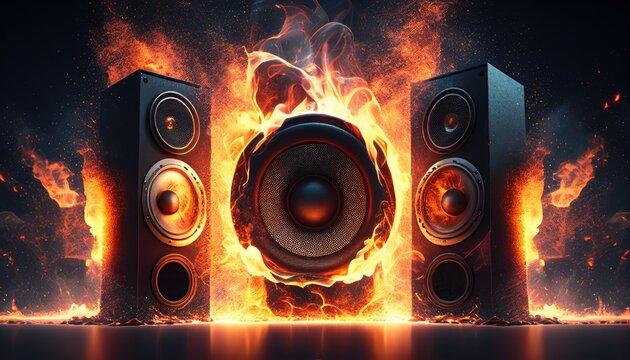Our relationship with music has progressed tremendously alongside advancements in technology. From rudimentary gramophones to high-fidelity (hifi) audio systems, our musical journey has been defined by the pursuit of authentic sound. This quest has led us to the domain of high-resolution audio – an immersive sonic experience that satiates even the most discerning audiophile. Let’s explore the evolution of music reproduction, the science behind high-resolution formats, and what constitutes an exemplary hifi music system for home.
The Evolution of Music Reproduction
The history of music playback mirrors our constant endeavour to capture a performance as faithfully as possible. In 1877, Thomas Edison unveiled the phonograph, which used cylinders wrapped in tin foil to play short recordings. This was followed by Emile Berliner’s gramophone in 1887, marking the advent of flat discs. Early recordings were entirely acoustic and offered limited audio quality in their music system.
The introduction of electronic recording in 1925 transformed fidelity, capturing a fuller frequency range. Further milestones like FM radio (1933), stereo records (1958), cassettes (1963), and the compact disc (1982) expanded accessibility and enhanced the quality of hifi music systems for home. The digital revolution spawned new possibilities for high-definition music reproduction.
Defining High-Resolution Audio
High-resolution or Hi-Res audio refers to music files that exceed the quality of conventional formats like CD and MP3. While CDs have 16-bit depth and 44.1 kHz sampling rate, Hi-Res formats typically have:
- Bit depth of 24 bits or higher
- Sampling frequency of 96 kHz or higher
Higher bit depth means a wider dynamic range – the difference between the quietest and loudest sounds. This adds nuance and realism. Higher sampling rates enable a broader frequency response, delivering the complete audible spectrum from deep bass to sparkling highs. Together, these enhance clarity and immersion in a hifi music system for home.
Popular high-resolution formats include FLAC, ALAC, WAV, and DSD. High-res streaming services like Tidal and Qobuz offer expansive music libraries. This wealth of content makes hifi audio systems more accessible than ever.
The Benefits of High-Resolution Music
Upgraded digital specs unlock several advantages in a music system for home:
- More realistic and lively soundstage – Instruments and vocals are positioned with holographic precision.
- Improved instrumental separation – Even dense arrangements with many sounds are easier to discern.
- Fuller and extended frequency range – The entire spectrum is reproduced faithfully, not compressed.
- Greater sense of depth and space – Subtle reverb, delays, and room cues become apparent.
- Captures finer nuances – Gentle inflections in vocals and playing are revealed.
- Together these attributes provide a profoundly engaging and emotional listening session that connects you to the music in a hifi sound system for home.
Components of a High-Resolution Audio System
To unlock high-resolution audio’s capabilities requires a system with synergistic audiophile-grade components. Let’s examine the key elements of a hifi music system for home:
- Source – This provides the high-resolution music signal. Blu-ray players, dedicated servers, and streamers like the Bluesound Node meet this need. Turntables play analogue vinyl records in a hifi sound system for home.
- DAC – The Digital to Analog Converter interprets the digital signal and converts it into a line-level analogue output. Great DACs employ premium components for clean conversion.
- Pre-amp – Provides input switching, volume control, and signal routing functions. Separate pre-amps permit flexibility, but integrated amps combine this in a hifi music system.
- Power Amp – Boosts the pre-amp’s output to sufficient wattage to drive the speakers. Audiophile amps utilize high-end power supplies and components.
- Speakers – These turn electrical signals into sound. Ideal audiophile speakers feature premium driver materials, bespoke crossovers, and rigid cabinets in a hifi sound system.
- Cables – High-quality cables ensure an uncoloured path between components. Many brands focus exclusively on cutting-edge cable technologies for their hifi sound system price.
The Audiophile’s Pursuit of Audio Nirvana
There is a thriving community of audiophiles on a constant quest for audio nirvana. Online forums like Head-Fi and the Audiophile Style connect like-minded individuals to discuss equipment, music, and their shared passion. In-person gatherings like audio shows provide opportunities to experience systems first-hand in a hifi music system for home.
Audiophiles also enjoy debating analogue vs digital. Some believe LPs and turntables capture nuances lost in digital formats. Others consider high-resolution files equal or superior to vinyl. This hunger to push fidelity advances the state of the art in hifi audio systems.
Influences on High-End Audio System Pricing
This pursuit carries a substantial sound system price tag. Cost is influenced by:
Brand heritage – Legacy brands like McIntosh trade on history and reputation.
Materials quality – Exotic woods, metals, composites justify premium sound system price.
Technology – Patented innovations command higher prices, e.g. KEF’s Uni-Q driver.
Hand-crafting – Brands creating bespoke hand-built components factor in immense labour and skill.
Customization – Tailored systems with personalized aesthetics and tuning escalate sound system price.
Support – Good service and warranties add value. Some boutique brands offer lifetime support.
While not cheap, one must consider the years of enjoyment a system provides. There is also a positive correlation between investment and fidelity in a hifi music system for home.
Conclusion
In closing, while in its infancy, the gramophone provoked amazement. Today, high-resolution audio represents the pinnacle of our musical journey. These bespoke audio systems provide a listening experience unmatched in authenticity and immersion. For devoted music lovers, the substantial investment is justified manifold by the ability to connect with music at the most profound level. As technology progresses, high-resolution audio will hopefully become ubiquitous. But for now, it remains an audiophile’s delight in a hifi sound system for home.















